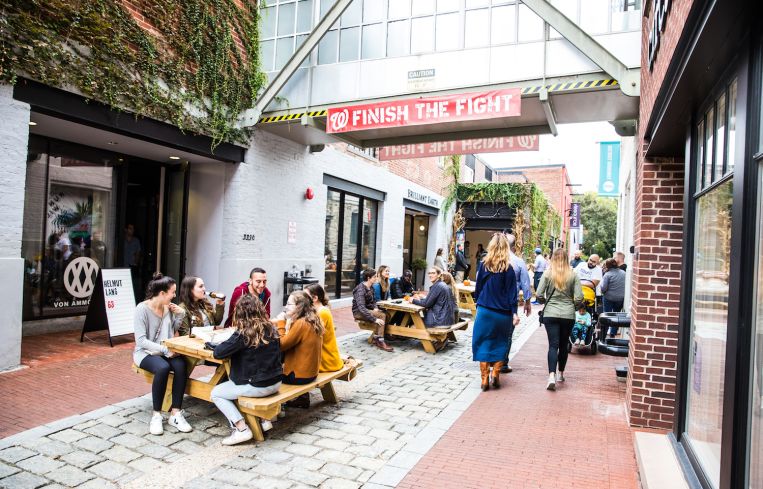DC Neighborhoods Look to Create Pedestrian Zones
By Keith Loria June 2, 2020 1:09 pm
reprints
Last winter, EastBanc obtained permits to shut down Cady’s Alley in Georgetown, allowing for pedestrian-only traffic in the busy Washington, D.C. neighborhood. The cleared out street created a safer shopping experience during the busy holiday season and gave people a destination to gather just off of busy M Street.
With restaurants and retailers now looking to open back up, as D.C. has officially enacted phase 1 of its COVID-19 reopening plan, many in the region are looking to follow what EastBanc found success with before the coronavirus was even a thing.
Many neighborhoods are looking to establish pedestrian zones and spaces designated for outdoor seating as restaurants plan for reopening, with early efforts centered around the Eastern Market, Petworth and Adams Morgan neighborhoods. Restaurants in these areas are following guidelines that limit service to outside dining, tables six feet apart, and of six patrons per table.
There are many players involved in the permits, including the Department of Transportation, Department of Public Works and the DC Council among them.
“D.C. is appreciating the community’s needs to support business and safe social interaction and appears to be accelerating approvals to extend curbsides and open streets on weekends,” Philippe Lanier, EastBanc’s principal told Commercial Observer. “This allows for outdoor seating and protects against the consequence of lines forming to enter popular retail locations.”
He explained that typically, the tenant would apply for their own space permit but when talking about a neighborhood-wide effort, it requires property owners to get involved.
From his past experience of closing Cady’s Alley to vehicles on weekends, Lanier has seen the positive impact it can have on the businesses and the consumers’ experience, particularly for families with young children, and people with bikes and scooters.
“Today this type of approach is critical to a return to normalcy,” he said. “We are already in the process of gathering the support and authority for a more permanent closure. The trial allowed for safer pedestrian traffic through the alley, creating a rare gathering space in the heart of Georgetown. The permit also helped boost the businesses of Cady’s Alley and introduced them to shoppers that may not have traveled down the alley otherwise.”
Lanier believes the city will likely create pilot programs providing businesses with the space to expand and solicit community feedback before advancing to a more permanent approach.
“They have been requiring all businesses preparing to open for phase one, and possibly two, to file online their intent to do so,” he said. “There will be policing on which businesses are operating safely or may have their ability to operate revoked. I have not seen a sign of a more elaborate permit process yet; but that is the eventual nature of government, it may come.”
The speed at which restaurants take advantage of the extra space depends on their access to furnishing, creativity and capital. Many of the local Business Improvement District (BID) boards are expected to use their resources to support these efforts, neighborhood by neighborhood.
For example, EastBanc and its partners began working with the Georgetown BID before coronavirus on a plan to remove the street parking along M Street in order to expand the sidewalks, and this initiative is only becoming more relevant now.
“As restaurants and retailers set capacity restrictions, snaking lines are inevitable,” Lanier said. “In order to maintain social distancing and provide for a safe, comfortable shopping experience, it’s important that we provide enough space outdoors to compliment tenants’ in-store experience.”
The Wharf is also marking the abundant outdoor seating areas to help people maintain proper physical distance. Cabana-style seating will be added on District Pier to provide additional opportunities for enjoying the waterfront without overcrowding.
“The Wharf was designed with abundant common area space for the enjoyment of our community. As a result, we are able to repurpose spaces throughout the neighborhood to expand our outdoor dining options without sacrificing pedestrian access,” Monty Hoffman, Hoffman & Associates’ founder & chairman, told CO. “The result is a safe way to experience the waterfront so many of us have missed.”


